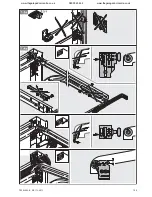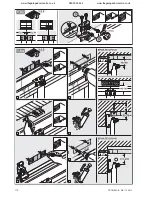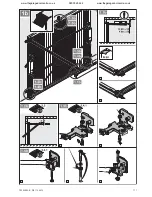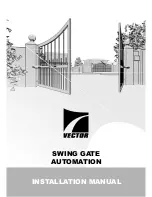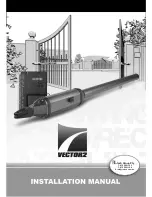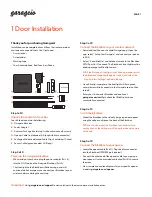
2 .6
Safety instructions for initial start-up and
operation
WARNING
Danger of injury during door travel
▶
See warning in section 6
Danger of injury by fast-closing door
▶
See warning in section 6.2.1
CAUTION
Crushing hazard in the boom
▶
See warning in section 6
Danger of injury from the cord knob
▶
See warning in section 6
Danger of injuries due to the hot lamp
▶
See warning in section 6 and 7.3
2 .7
Safety instructions for using the hand
transmitter
WARNING
Danger of injury during unwanted door travel
▶
See warning in section 5
CAUTION
Danger of injuries due to unintended door travel
▶
See warning in section 5
2 .8
Approved safety equipment
Safety relevant functions or components of the control, such
as the force limit, external photocells and closing edge safety
device, have been designed and approved in accordance with
category 2, PL “c” of EN ISO 13849-1:2008.
WARNING
Danger of injuries due to faulty safety equipment
▶
See warning in section 4.2
3
Fitting
3 .1
Inspecting the door / door system
DANGER
Compensating springs are under high tension
Serious injuries may occur while adjusting or loosening the
compensating springs!
▶
For your own safety, only have a specialist conduct
work on the door compensating springs and, if
necessary, maintenance and repair work!
▶
Never try to replace, adjust, repair or reposition the
compensating springs for the counterbalance of the
door or the spring mountings yourself.
▶
Furthermore, inspect the entire door system (joints,
door bearings, cables, springs and fastening parts) for
wear and possible damage.
▶
Check for the presence of rust, corrosion, and cracks.
A fault in the door system or an incorrectly aligned door
may lead to serious injuries!
▶
Do not use the door system if repair or adjustment
work must be conducted!
The construction of the operator is not designed for operation
with sluggish doors, that is, doors that can no longer be
opened or closed manually, or can only be opened / closed
manually with difficulty.
The door must be in perfect mechanical condition, so that it is
easy to operate by hand (EN 12604).
▶
Lift the door by approx. one metre and let it go.
The door should stay in this position and
neither
move
downward
nor
upward. If the door does move in either
direction, there is a danger that the compensating
springs / weights are not properly adjusted or are
defective. In this case, increased wear and
malfunctioning of the door system can be expected.
▶
Check whether the door can be opened and closed
correctly.
▶
The mechanical locking devices of the door that are not
needed with a garage door operator must be put out of
commission. This especially includes the locking
mechanisms of the door lock (see section 3.3.1 and
section 3.4.1).
▶
Switch to the illustrated section for the fitting and
initial start-up . Observe the respective text section
when you are prompted to by the symbol for the text
reference .
3 .2
Clearance required
▶
See figure
1 .1a
/
1 .2b
The clearance between the highest point of the door travel
and the ceiling must be
at least 30 mm
.
If the clearance is smaller, the operator can also be mounted
behind the opened door if enough space is available. In such
cases, an extended fitting bracket has to be used, which must
be ordered separately (see Accessories for the garage door
operator / C1).
The garage door operator can be arranged up to max. 50 cm
off-centre. The electric socket necessary for the electrical
connection should be fitted
approx . 50 cm
from the operator
head (note section 4
Mains voltage
).
▶
Check these dimensions!
TR10L003-B RE / 12.2013
23
ENGLISH
www.thegaragedoorcentre.co.uk
0800 525 442
www.thegaragedoorcentre.co.uk


















